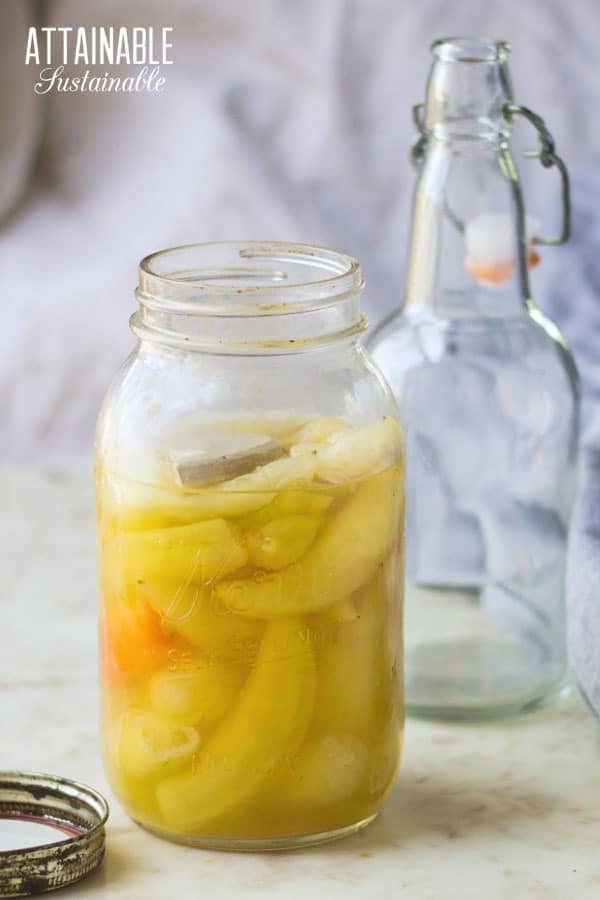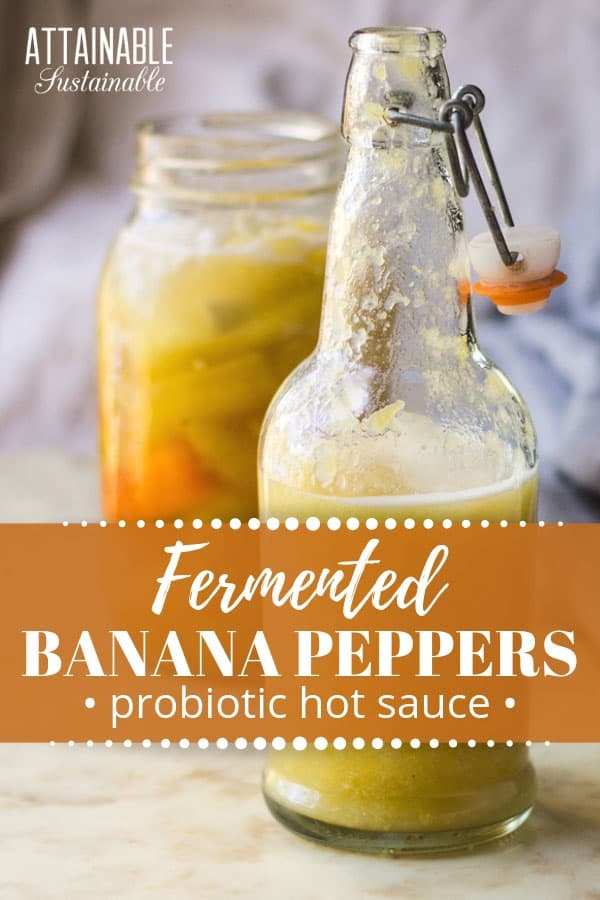This fermented banana pepper sauce makes a spicy condiment packed full of flavor and probiotics. Better yet? This banana pepper recipe is a snap to make!
If you love spicy ferments, be sure to check out this fermented pepper relish, too!
Contributed by Shannon Stonger

New to fermenting foods? Be sure to read this compilation of frequently asked questions before you get started!
I have had two jars filled with good food sitting on my counter for eleven months now and neither of them has gone bad. These jars were filled last September with some organic hot banana peppers I had purchased in season and wanted to preserve.
Easy Fermentation
With very little effort and zero heating or freezing of the food, they practically preserved themselves with this easy fermented banana pepper sauce.
And now that I am getting ready to fill more jars with vegetables, salt, and water, it’s time for them to reach their final destination – fermented hot sauce!
5 Easy Steps to Transform Your Pantry!
Ready to switch from store bought to homemade? Let me help you make some changes! Grab my FREE five-part guide to getting started.
Fermentation, as I go on and on about in my book, is probably the easiest, safest, healthiest way to put up your harvest. Not to mention the fact that fermentation makes the best, most nuanced hot sauce, in my opinion.
The aging of the banana peppers, the melding of the flavors, the lactic tang of the brine all come together in wonderful harmony.
Ingredients
Banana peppers — While this recipe will work with any type of banana pepper – or any type of pepper at all! – if you want this to be a hot sauce, be sure to choose hot banana peppers.
Fresh garlic — The addition of a couple of garlic cloves to this ferment provides the pungent flavor we love.
Sea salt — Opt for sea salt here, or another natural salt without any additives like iodine or anti-caking agents. Table salt often has anti-caking agents that can interfere with the fermentation.
Making this Fermented Hot Sauce
Wash and dry fresh banana peppers. Pack the peppers and garlic into a quart-size jar until 80% full. Note that this recipe can be made in upcycled jars; no need to tie up your canning jars with this recipe!
Add the salt to the peppers and then fill with filtered water to completely submerge the vegetables.
Use a fermentation weight to hold the peppers below the level of the brine. Cover with an airlock or lid.
Allow the jar to sit at room temperature for four weeks, burping the jar daily for the first two week to release the carbon dioxide that develops.
Once fully aged and tangy, transfer the peppers, garlic, and 1/3 of the brine to a blender and process until smooth.
The Handcrafted Pantry

Ready to DIY your pantry with more wholesome ingredients? Check out my ebook, The Handcrafted Pantry! Filled with delicious recipes for some of your favorite condiments, snacks, and toppings, it’s the guide you need to start skipping packaged products and embrace homemade.
It’s almost too good to be true. But it’s not. It’s real and it’s easy, and it’s filled with enzymes and probiotics to boot. And don’t just toss the brine when you are done blending your hot sauce. There are plenty of uses for that too!
Storing this Banana Pepper Sauce
One the sauce is ready, store it in a flip top bottle in the refrigerator. Use this banana pepper hot sauce liberally to flavor your favorite dishes.
And make note to plant some banana peppers in your garden next year so you can make this recipe again!
★ Did you make this banana pepper sauce? Don’t forget to give it a star rating below!

Banana Pepper Recipe: Fermented Hot Sauce
Ingredients
- 1 scant quart hot banana peppers stems removed
- 2 cloves garlic peeled
- 2 ½ tablespoons sea salt
- chlorine-free water as needed
Instructions
- Pack the peppers and garlic into a quart jar until 80% full. Add the salt to the peppers and then pour over the water to completely submerge the vegetables. Use a fermentation weight or homemade alternative to weigh the peppers down to below the level of the brine.1 scant quart hot banana peppers, 2 cloves garlic, 2 1/2 tablespoons sea salt, chlorine-free water as needed
- Seal the jar with a canning lid and ring or an airlock and leave to ferment at room temperature for at least four weeks. During this time if you haven't used an airlock, you will need to "burp" your jar daily for the first two weeks in order to release the carbon dioxide produced by the fermentation process.
- After four weeks the peppers should be tangy and fully aged and fermented. They will keep for months in cold storage - a cellar or refrigerator - or even at room temperature.
- When you are ready to prepare the hot sauce, simply place the peppers, garlic, and 1/3 of the brine from the jar into a blender. Blend, adding more brine as needed to achieve the proper consistency. You can also blend it in a wide-mouth canning jar if you have an immersion blender. Taste and add salt or apple cider vinegar if you feel it needs some extra kick.
- The hot sauce should then keep for weeks refrigerated or on the table.
Nutrition
More Recipes for Fermentation:
If you loved this recipe (and the idea of adding more probiotics to your diet!) there’s so much more exploring to do!
These spicy fermented snap peas are a delicious addition to a salad, chop them in small bits and add to your deviled eggs, or serve them alongside a cold beer.
Try these fermented carrots with garam masala seasoning for something different.
Try fermenting cauliflower to serve with your favorite sandwich.










I love these helpful suggestions and recipes. Thank you for sharing.
Can you can this after the process is done instead of keeping in the fridge? I would like to mke many batches at one time
I wouldn’t because it would kill all of the good bacteria and probiotics from the ferment.
Followed recipe faithfully, watched the bubbles come up everyday. Cleaned weights daily, never any scum or signs of mold. I was so excited to bottle today, blended it in the Ninja. Tasted it, it was awful. WAY TOO SALTY!!!! So disappointed, I threw both batches out. There was no taste difference between each jar. I will try again with a lower salt ratio.
Darn! Better luck next time.
Would you want to add any vinegar to this?
thx
It’s not necessary.
Made this with whatever peppers I had so good. I ferment a lot, and I believe…..this will last, once fermented, in the fridge for many months. My sauerkraut, which is just cabbage and salt, is still crunchy after a year. Wonder why this would be different. Also, can canning salt be used in place of fine sea salt?
You can use any natural salt without any additives like iodine or anti-caking agents.
Hi Angela, I am very intrigued by your crispy sauerkraut. How did you manage to keep it crunchy? or can you please tell me your method of fermenting cabbage? Vivien
How do you use the extra brine?
The brine can be used as a “kickstart” to another ferment, or stirred into salad dressing, pasta salad, etc.
Thanks so much for your recipe. Around here we love Hungarian Hot Wax peppers and grow them every year, along with other hot peppers. I will be trying your recipe very soon.
I am curious … can we do the same fermentation with other peppers too? Could we use a combination of peppers, making a combo fermented pepper sauce?
This year in addition to the Hungarian Hot Wax peppers we have grown Serrano’s and Cayenne. The previous year we grew Cow Tails, Fresno, Cayenne, Hot Wax and Serrano.
Yes, you could try that. It would probably be delicious!
So I tried this recipe and when I opened the jar there was mold on the top. What did I do wrong?
Usually, mold happens when vegetables are not fully submerged in the brine during fermentation.
I skim the top, and it is fine. The white filmy mold is fairly normal. I fill a heavy ziplock with salted water (in case of a leak), and use that as a weight to hold down fermented foods. Creates a nice seal. And yes, I still burp.
These look fantastic! Any reason why I couldn’t use a jalapeno pepper in place of the banana pepper?
I haven’t tried it, but you could use jalapenos. It will have a different flavor and be much spicier.
What does airlock mean?
It’s a contraption that you put on the jar that allows air bubbles out but no air IN.
Is it okay to cut the banana peppers in half in order to get more peppers in the jar?
Yes, of course!
Is that 2.5 tablespoons of sea salt or teaspoons?
Tablespoons. Thanks; I’ll spell that out right no.
Thanks!
do you dry your banana pepper seed for replanting? How?
maybe this will help? https://www.attainable-sustainable.net/seed-saving/
Do you burp at all for the last 2 weeks?
If you’re not using a lid with an airlock or similar, it’s a good idea to burp, yes.
When you say to remove the stem, does this also mean removing all of the seeds? Or do you leave those? Excited to try this! Just started growing our own banana peppers, and wanted to make hot sauce with them.
You can remove or keep the seeds, as you like. The seeds/membranes are where the heat is, so this is a good way to “moderate” the spiciness.
What does it mean to “burp” the jar?
Just to open it up and allow any built up gasses to release. Easy, peasy.
My end of harvest garden yielded banana peppers and peppadews. I have a fermenting crock and was thinking of fermenting both together and then making a hot sauce. Your thougthts?
My thoughts: What are peppadews??
(Peppadew: a small, sweet pepper with a little heat. I think someone branded the name, as they are found in glass jars at stores).
Where are the bananas? The recipe says bananas, but I don’t see them used in the steps.
I can see the confusion, but this recipe calls for a variety of pepper called a BANANA PEPPER. No bananas. 🙂
After the fermenting why can’t you blend all and bottle
You mean to make it shelf stable? I’m not comfortable saying that would be safe. Peppers are a low-acid food and not safe to water bath can. You’d need someone to check this recipe for the safety of that.
Can you give some examples of where you would use this sauce? We like spicy food but don’t often use hot sauce.
On tacos, stirred into chili, used as a seasoning when cooking things that need a little extra flavor.
Good flavor, but a bit spicy!
Just wondering if this would work with a salt alternative? I have someone who can not have the salt.
Fermenting may not be for you, then. Salt is key in the preservation process. Try pickling?
I was surprised to read on the label of the apple cider vinegar that it contained no salt. So my pepper sauce was sodium free. I had always thought vinegar contained a lot of salt.